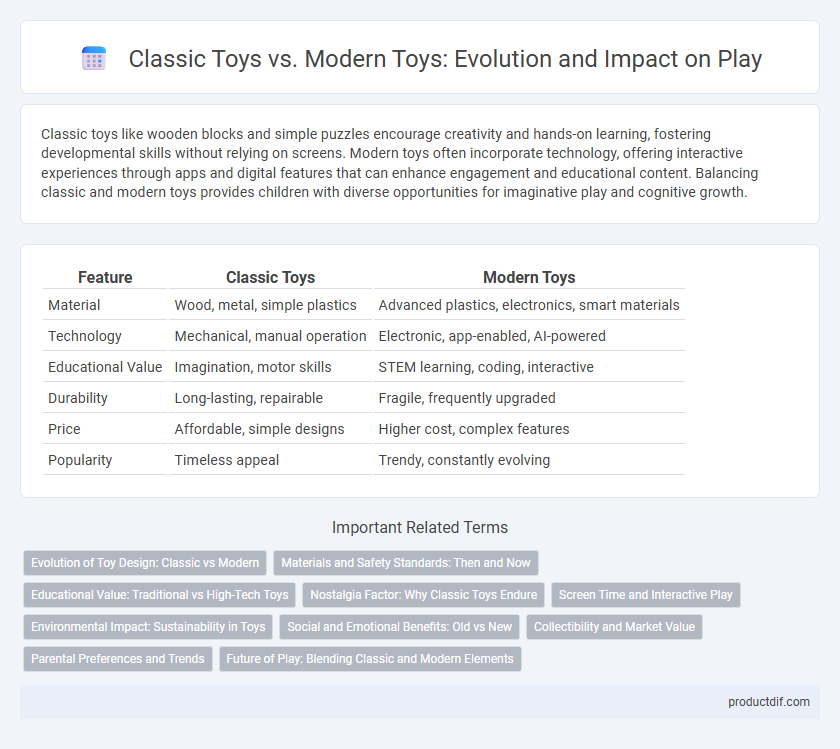Classic toys like wooden blocks and simple puzzles encourage creativity and hands-on learning, fostering developmental skills without relying on screens. Modern toys often incorporate technology, offering interactive experiences through apps and digital features that can enhance engagement and educational content. Balancing classic and modern toys provides children with diverse opportunities for imaginative play and cognitive growth.
Table of Comparison
| Feature | Classic Toys | Modern Toys |
|---|---|---|
| Material | Wood, metal, simple plastics | Advanced plastics, electronics, smart materials |
| Technology | Mechanical, manual operation | Electronic, app-enabled, AI-powered |
| Educational Value | Imagination, motor skills | STEM learning, coding, interactive |
| Durability | Long-lasting, repairable | Fragile, frequently upgraded |
| Price | Affordable, simple designs | Higher cost, complex features |
| Popularity | Timeless appeal | Trendy, constantly evolving |
Evolution of Toy Design: Classic vs Modern
Classic toys emphasize simple materials like wood and metal, showcasing timeless craftsmanship and durability, while modern toys integrate advanced technology and interactive features, enhancing user engagement and learning experiences. The evolution of toy design reflects shifts in educational priorities, safety standards, and digital innovation, transforming play patterns from imaginative mimicry to dynamic, tech-driven interactions. This progression highlights the balance between nostalgic value and contemporary appeal in the toy industry.
Materials and Safety Standards: Then and Now
Classic toys were often made from natural materials like wood, metal, and fabric, which offered durability but sometimes posed safety risks due to splinters, sharp edges, or small detachable parts. Modern toys utilize advanced, non-toxic plastics and synthetic materials designed to meet stringent international safety standards such as ASTM F963, EN71, and CPSIA, significantly reducing choking hazards, chemical exposure, and injury risks. Regulatory advancements and material innovation have transformed toy manufacturing, prioritizing child safety while maintaining play value.
Educational Value: Traditional vs High-Tech Toys
Classic toys like wooden blocks and puzzles promote hands-on learning and motor skill development, fostering creativity through tactile engagement. Modern high-tech toys integrate interactive features and digital interfaces that enhance cognitive abilities and problem-solving skills with adaptive learning technology. Both types offer significant educational value, with traditional toys emphasizing foundational skills and modern toys providing dynamic, personalized learning experiences.
Nostalgia Factor: Why Classic Toys Endure
Classic toys endure because their nostalgic value connects generations, evoking childhood memories that modern toys often lack. Iconic items like LEGO sets and wooden trains offer timeless appeal through simple, imaginative play. Modern toys tend to emphasize technology and electronics, but classic toys maintain lasting emotional resonance rooted in tradition and shared experiences.
Screen Time and Interactive Play
Classic toys encourage imaginative play and limit screen time, promoting fine motor skills and creativity through tactile interaction. Modern toys often integrate digital screens and interactive features that enhance cognitive engagement but can increase screen exposure. Balancing traditional toy use with screen-based interactive play supports healthy development and varied learning experiences.
Environmental Impact: Sustainability in Toys
Classic toys often feature natural materials like wood and metal, which are biodegradable and have a lower environmental impact compared to many modern plastic toys. Modern toys frequently contain non-recyclable plastics and electronic components that contribute to landfill waste and resource depletion. Prioritizing sustainably sourced materials and eco-friendly manufacturing processes can significantly reduce the environmental footprint of both classic and contemporary toys.
Social and Emotional Benefits: Old vs New
Classic toys like wooden blocks and dolls promote imaginative play and foster essential social skills such as cooperation and empathy through face-to-face interactions. Modern toys often incorporate technology, offering interactive features that support emotional recognition and digital communication skills but may reduce physical social engagement. Balancing traditional and contemporary toys can enhance children's social and emotional development by combining hands-on creativity with digital literacy.
Collectibility and Market Value
Classic toys such as vintage action figures and original board games often hold higher collectibility and market value due to nostalgia and limited availability, attracting serious collectors and investors. Modern toys with digital integration or limited edition releases are increasingly gaining value but generally lack the historical significance that drives classic toy markets. Scarcity, condition, and brand reputation remain key factors influencing the long-term value and desirability of both classic and modern toys.
Parental Preferences and Trends
Parental preferences show a growing trend toward modern toys featuring educational technology and interactive elements that promote STEM learning. Classic toys like building blocks and dolls remain valued for fostering creativity, fine motor skills, and imaginative play. Market research reveals a balanced demand as parents seek toys that blend nostalgic qualities with innovative features to support child development.
Future of Play: Blending Classic and Modern Elements
Classic toys evoke nostalgia and timeless creativity, while modern toys integrate advanced technology for interactive experiences. The future of play combines traditional craftsmanship with digital innovation, enhancing imagination and engagement. This blend fosters developmental benefits by merging tactile learning with augmented reality and smart features.
Classic toys vs modern toys Infographic

 productdif.com
productdif.com